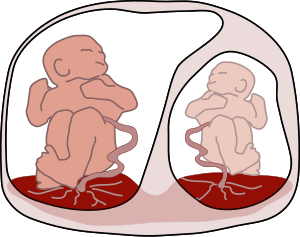Twin to twin transfusion syndrome
Other Names: TTTS; Twin-to-twin transfusion syndrome; Fetofetal transfusion syndrome; Fetal transfusion syndrome Twin to twin transfusion syndrome (TTTS) is a rare condition that occurs during a twin pregnancy when blood moves from one twin (the “donor twin”) to the other (the “recipient twin”) while in the womb. TTTS is a complication that specifically occurs in identical (monozygotic) twin pregnancies that share the same "egg" sac (monochorionic) that may or may not share the same amniotic sac (monoamniotic). TTTS usually develops between 15 and 26 weeks of pregnancy.

Cause
As a result of sharing a single placenta, the blood supplies of monochorionic twin fetuses can become connected, so that they share blood circulation: although each fetus uses its own portion of the placenta, the connecting blood vessels within the placenta allow blood to pass from one twin to the other. It is thought that most monochorionic placentae have these "shared connections" that cross the placenta, with the net flow volumes being equal between them.This state is sometimes referred to as "flow balance". When the placenta has deep vein-artery connection this can cause blood flow to become unbalanced. Depending on the number, type and direction of the interconnecting blood vessels (anastomoses), blood can be transferred disproportionately from one twin (the "donor") to the other (the "recipient"), due to a state of "flow imbalance" imparted by new blood vessel growth across the placental "equator", the line that divides each baby's proportion of the shared placenta. This state of transfusion causes the donor twin to have decreased blood volume, retarding the donor's development and growth, and also decreased urinary output, leading to a lower than normal level of amniotic fluid (becoming oligohydramnios). The blood volume of the recipient twin is increased, which can strain the fetus's heart and eventually lead to heart failure, and also higher than normal urinary output, which can lead to excess amniotic fluid (becoming polyhydramnios). The demise of the fetus is typically a result of ischemia related to the lack of blood flow. The lack of blood flow causes bowel atresia, brain damage, and kidney failure.
Symptoms
Most of the time, the donor twin is smaller than the other twin at birth. The infant often has anemia, is dehydrated, and looks pale. The recipient twin is born larger, with redness to the skin, too much blood, and a higher blood pressure. The twin that gets too much blood may develop cardiac failure because of the high blood volume. The infant may also need medicine to strengthen heart function. The unequal size of identical twins is referred to as discordant twins.
Diagnosis
This condition is most often diagnosed by ultrasound during pregnancy. After birth, the infants will receive the following tests:
- Blood clotting studies, including prothrombin time (PT) and partial thromboplastin time (PTT)
- Comprehensive metabolic panel to determine electrolyte balance
- Complete blood count
- Chest x-ray
Treatment
Treatment may require repeated amniocentesis during pregnancy. Fetal laser surgery may be done to stop the flow of blood from one twin to the other during pregnancy. After birth, treatment depends on the infant's symptoms. The donor twin may need a blood transfusion to treat anemia. The recipient twin may need to have the volume of body fluid reduced. This may involve an exchange transfusion. The recipient twin may also need to take medicine to prevent heart failure.
Prognosis
If the twin-to-twin transfusion is mild, both babies often recover fully. Severe cases may result in the death of a twin.
| Twin conditions | ||||||||
|---|---|---|---|---|---|---|---|---|
|
| Conditions originating in the perinatal period / fetal disease | ||||||||||
|---|---|---|---|---|---|---|---|---|---|---|
|
| Pathology of pregnancy, childbirth, and the puerperium | ||||||||||||
|---|---|---|---|---|---|---|---|---|---|---|---|---|
* ' Category'
|
NIH genetic and rare disease info
Twin to twin transfusion syndrome is a rare disease.
| Rare and genetic diseases | ||||||
|---|---|---|---|---|---|---|
|
Rare diseases - Twin to twin transfusion syndrome
|
Transform your life with W8MD's budget GLP-1 injections from $125.
W8MD offers a medical weight loss program to lose weight in Philadelphia. Our physician-supervised medical weight loss provides:
- Most insurances accepted or discounted self-pay rates. We will obtain insurance prior authorizations if needed.
- Generic GLP1 weight loss injections from $125 for the starting dose.
- Also offer prescription weight loss medications including Phentermine, Qsymia, Diethylpropion, Contrave etc.
NYC weight loss doctor appointments
Start your NYC weight loss journey today at our NYC medical weight loss and Philadelphia medical weight loss clinics.
- Call 718-946-5500 to lose weight in NYC or for medical weight loss in Philadelphia 215-676-2334.
- Tags:NYC medical weight loss, Philadelphia lose weight Zepbound NYC, Budget GLP1 weight loss injections, Wegovy Philadelphia, Wegovy NYC, Philadelphia medical weight loss, Brookly weight loss and Wegovy NYC
|
WikiMD's Wellness Encyclopedia |
| Let Food Be Thy Medicine Medicine Thy Food - Hippocrates |
Medical Disclaimer: WikiMD is not a substitute for professional medical advice. The information on WikiMD is provided as an information resource only, may be incorrect, outdated or misleading, and is not to be used or relied on for any diagnostic or treatment purposes. Please consult your health care provider before making any healthcare decisions or for guidance about a specific medical condition. WikiMD expressly disclaims responsibility, and shall have no liability, for any damages, loss, injury, or liability whatsoever suffered as a result of your reliance on the information contained in this site. By visiting this site you agree to the foregoing terms and conditions, which may from time to time be changed or supplemented by WikiMD. If you do not agree to the foregoing terms and conditions, you should not enter or use this site. See full disclaimer.
Credits:Most images are courtesy of Wikimedia commons, and templates, categories Wikipedia, licensed under CC BY SA or similar.
Contributors: Deepika vegiraju

